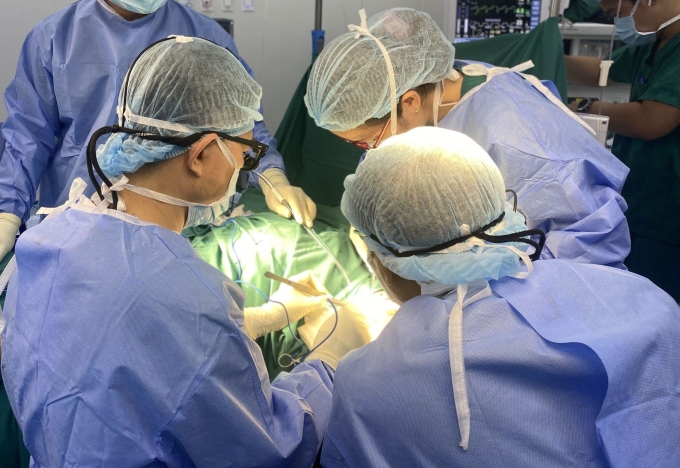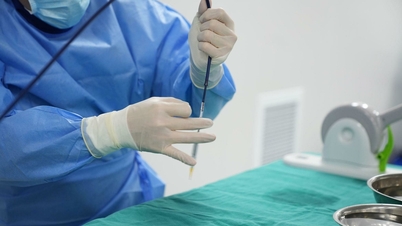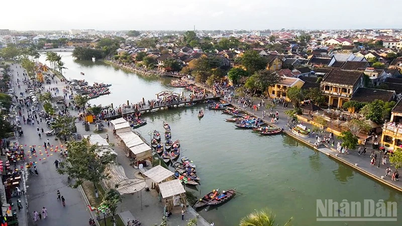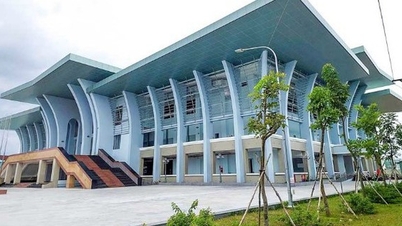The patient had intermittent pain when walking and cold feet. The doctor discovered that the blood vessels in the lower limbs were almost completely blocked, causing severe lack of blood supply to the legs, with the risk of necrosis.
Examination at Tam Anh General Hospital in Ho Chi Minh City, the ABI index (ratio between ankle artery blood pressure and brachial artery blood pressure) of Mr. Ngo Phong (77 years old, living in Cu Chi, Ho Chi Minh City) was 0.6 in the right leg and 0.5 in the left leg. This index decreased by 50% compared to normal people (ABI equal to 1), showing that both legs were very severely anemic. Ultrasound and CT scan to find the cause of anemia showed that the superficial femoral artery (artery near the skin surface, supplying blood to the legs) was almost completely blocked for a length of 10-15 cm in both legs.
Mr. Phong has a history of diabetes, high blood pressure, and dyslipidemia. A month before being hospitalized, he often had pain when walking about 10 meters, cold calves and feet, fatigue, and poor appetite.
When the arteries in the body are narrowed or blocked, the blood flow to the feet is reduced, anemia leads to cold feet. "If the blood vessels are not re-opened in time, the feet will not receive blood for a long time, the tissue will gradually die (necrosis), and the patient will be at risk of having to have the leg amputated," said Dr. Nguyen Anh Dung, Head of the Department of Cardiovascular and Thoracic Surgery, Cardiovascular Center.
According to Dr. Dung, there are two common methods in treating lower limb arterial occlusion, including angioplasty and stenting and bypass surgery. However, the patient was elderly and his blood vessels were so severely atherosclerotic that they were frozen, making it impossible to insert a catheter and place a stent. Therefore, the surgeon performed a femoropopliteal artery bypass surgery to restore blood flow to Mr. Phong's legs.

Dr. Nguyen Anh Dung and the team of Cardiovascular and Thoracic surgeons performed femoral artery bypass surgery on the patient. Photo: Tam Anh Hospital
First, the doctor breaks the saphenous vein valve in place (a vein with a one-way valve to return blood from the foot to the heart). Then, the doctor creates a bridge connecting the upper end of the saphenous vein to the upper femoral artery, and the lower end to the popliteal artery (after the femoral artery blockage) to direct blood from the upper thigh down to the foot (instead of going in the opposite direction). This is a modern method that is preferred in femoral artery bypass surgery. Experts do not need to take blood vessels from elsewhere but use the local saphenous vein as a bridge. The advantage of this technique is that it simplifies the surgical process, and the blood vessels have a lower risk of stenosis after surgery.
To perform this technique, the operating room must be equipped with modern valve breaking tools and machinery. At the same time, the surgeon must perform the valve breaking operation accurately to avoid valve failure leading to leg swelling and difficult-to-heal leg ulcers.
After the surgery, Mr. Phong was able to practice walking gently. The surgical wound healed quickly, blood circulation to the legs was good, the legs warmed up and became rosy. At the same time, he practiced physical therapy to recover quickly.
Doctor Dung said that the main cause of lower limb arterial occlusion comes from cardiovascular diseases such as: dyslipidemia, myocardial infarction, heart valve disease, arterial aneurysm... To prevent the disease, each person needs to limit foods containing a lot of bad fats; exercise regularly, avoid being overweight or obese; do not smoke, do not abuse alcohol; treat and control blood lipids... Patients with atherosclerosis, diabetes, high blood pressure... need to check their feet regularly, detect wounds, ulcers, blisters, color changes... and must go to the doctor immediately.
Thu Ha
Source link


![[Photo] Prime Minister Pham Minh Chinh received Mr. Yamamoto Ichita, Governor of Gunma Province (Japan)](https://vphoto.vietnam.vn/thumb/1200x675/vietnam/resource/IMAGE/2025/10/21/1761032833411_dsc-8867-jpg.webp)

![[Photo] Da Nang residents "hunt for photos" of big waves at the mouth of the Han River](https://vphoto.vietnam.vn/thumb/1200x675/vietnam/resource/IMAGE/2025/10/21/1761043632309_ndo_br_11-jpg.webp)
![[Photo] Prime Minister Pham Minh Chinh meets with Speaker of the Hungarian National Assembly Kover Laszlo](https://vphoto.vietnam.vn/thumb/1200x675/vietnam/resource/IMAGE/2025/10/20/1760970413415_dsc-8111-jpg.webp)


































































































Comment (0)